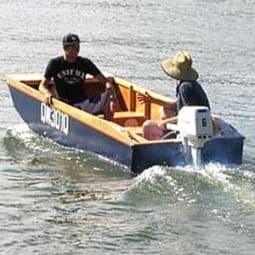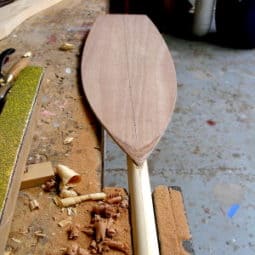There are two tricks to sikaflexing between timber veneer strips for a laid deck appearance for boats and lots of ways to do the job wrong – so use these methods to avoid failure.
It’s quite common for teak, Australian white beech or other oily timber strips to be left natural without varnish.
The normal thing with filling the gaps with Sikaflex is to slightly overfill the gaps then sand the top surface of the whole shebang down flush when the sika is cured.. The veneers do need to be a minimum of about 4mm – gives you enough meat to get stuck into it. Maybe 3mm is OK if you are careful with the sanding.

The right Primer improves adhesion to the boat deck dramatically
Use the Sika Primer – it improves the bond strength to the timber for a permanent job. You can get away without it often, but it changes the situation from a fairly strong bond to a hugely strong bond (you’ll know this if you have ever removed a window where the primer has been used – BAAAAD idea in that application – windows have to be replaced from time to time so don’t use the primer)
The second thing to know takes a little bit of explaining – how to stop the sealant cracking.
If it is not sealed and the teak veneers are relatively thick (4mm and up) it is common to run a plastic or paper tape along the bottom of the gap so the sika will only stick to the teak and not the ply substrate (the ply deck).
If it is not sealed and the teak veneers are relatively thick (4mm and up) it is common to run a plastic or paper tape along the bottom of the gap so the sika will only stick to the teak and not the ply substrate (the ply or fibreglass deck).
The reason is that the teak will change dimensions as it gains and loses moisture.
This will stretch and squeeze the sika during the drying and soaking cycles of use.
But if the sika or 5200 is stuck to the deck adjacent to the teak that will prevent it stretching.
CRACKS!
Why does the Sealant crack if stuck to the deck substrate?
Where the Sika is stuck only to the teak strips there is perhaps a 6mm gapa and if the Teak expands and contracts a mm the Sika is only being asked to stretch plus or minus 15 percent – it can cope easily.
However if it is stuck to the substrate there is much less than 6mm between adjacent bonded surfaces. The sika bonded to the substrate is immediatly adjacent to the sika bonded to the edge of the teak strip.
So one mm of movement down near the corner where the teak meets the substrate may mean you are asking the Sika to stretch 100, 200 or 300 percent.
The end result is that the sika starts tearing in the bottom corner and with repeated drying and wetting cycles the tear will proceed slowly up the face of the teak until the sika tears away from the teak on one side of the gap.
Difficult to repair too – you can only rip it all out and start again.
AND it is going to be already stuck to the decks – UGH!
So use release tape to prevent the teak sticking to the substrate. Sika sell “special tape – or you can just use a narrow plastic tape – it doesn’t need to be permanent – its only purpose is to make sure the bond between the sika and substrate is not strong so the sika will tear away from he substrate and not the sides of the teak planks/veneers
Problems with oily timbers and adhesion – Teak, Australian Beech and others.
Oily timbers need to have their surfaces stripped of oil immediately before bedding down in the epoxy. Simply brush a visible layer of acetone on the side that will be glued and wipe it off immediately (before it dries) with a clean cloth.
Our Boatbuilding and Boat Repair FAQ



















